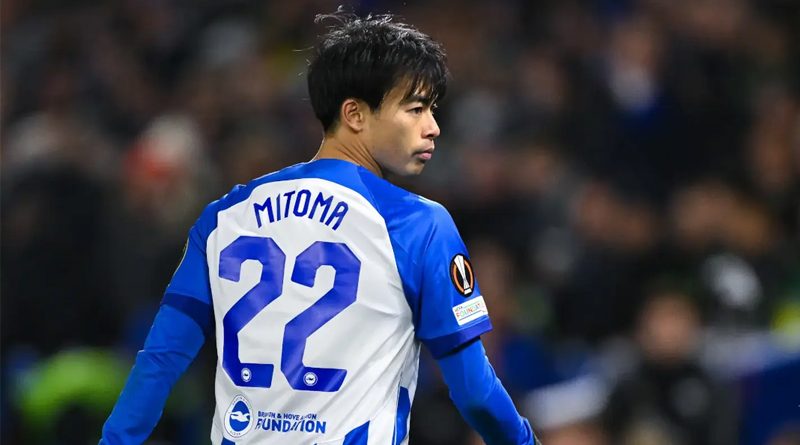Tatsu ka taoreru ka: Brighton set to take Japan by storm
Thanks to Kaoru Mitoma, Brighton and Hove Albion are big in Japan. That is about to explode with the Seagulls swooping into the land of chrysanthemums and cherry blossom for two pre-season fixtures against top J-League sides, something Mitoma says is rare.
Football – or soccer sakkā as it is more commonly known there – is rated as the nation’s third most popular sport after baseball and sumo wrestling.
According to JapanTours.com, football was introduced to the country by Lieutenant-Commander Archibald Lucius Douglas of the British Royal Navy. He taught it to Japanese navy cadets between 1873 and 1879.
But it wasn’t until the 1960s that an organised, semi-professional league was first established in Japan.
Football boomed in popularity amongst Japanese kids in the 1980s thanks to a soccer-playing manga character called Captain Tsubasa.
Registered players increased from under 70,000 to over 250,000 during the course of Captain Tsubasa‘s eight-year run.
Today, around 5.3 million play soccer at some level out of a Japanese population of 121 million in total. Around 12 percent watch J-League soccer on TV or online, according to Statista.com.
Like the Premier League, the J-League was founded in 1992. Now made up of three divisions, the top tier J-1 clubs had revenue collectively of ¥86.4 in 2023, around £420 million. The Premier League in comparison has a revenue of £6 billion.
The women’s WE League was established in 2021, and the women’s national side won the World Cup in 2011.
Albion’s first opponents in Japan are Kashima Antlers, the nation’s most decorated football club in terms of trophies.
They have won an unprecedented 19 major domestic titles including a record eight J-League titles, a record six J-League Cups and five Emperor’s Cups.
Their dominance is comparable with Manchester City, just without the 115 alleged breaches of league financial fair play rules, persumably.
The Antlers – along with Yokohama F Marinos, Urawa Red Diamonds, Sanfrecce Hiroshima and Mitoma’s former side Kawasaki Frontale – make up the J-League ‘big five’.
Urawa Red Diamonds are the best supported club, attracting an average crowd of 37,000. The Antlers averaged around 22,500. The Albion’s other opponents Tokyo Verdy attract around 20,500 on average.
In the J-League, each club’s main stadium is referred to as its ‘hometown.’ The pitch belongs to the people; teams have no proprietary rights over it, a notion unlikely to gain much traction here.
From elementary school to university, every school has a comprehensive training system, professional football pitches, and matches.
It is a sad contrast to the UK where over 200 schools have been forced to sell their sports pitches between 2010 and 2020.
The All Japan High School Soccer Tournament is very popular, comparable to US high school football in terms of viewing figures and prestige, relative to the top leagues. High school baseball draws bigger audiences though.
As attested to by Mitoma – who famously did his dissertation on dribbling at at Tsukuba University – students can be professional football players without hindering their academic degree.
The Japanese national football team, known as the Samurai Blue, have won the AFC Asian Cup a record four times. They were successfull in 1992, 2000, 2004 and 2011.
A record in continental international competition those of us in England can only look at in envy.
Japan have qualified for the the last seven consecutive FIFA World Cups, reaching the second round in 2002 (as co-hosts), 2010, 2018 and most recently in 2022. They exited Qatar on penalties in the round of 16 to semi finalists Croatia.
The Japanese PFA has named Mitoma as Player of the Season two years running. The award has only existed for two years, so it in fact makes Mitoma the only winner.
That is a measure of just how huge a star Mitoma is in his home nation. Regulars at the Amex of course already know this with the sheer number of Japanese football supporters who now flock to Falmer.
One fan I met at the FA Cup semi final at Wembley in 2023 had flown for 24 hours to visit London for one day to watch Mitoma in the world’s most famous cup competition.
Mitoma is not alone in breaking into the bigger European leagues. Around 100 Japanese players feature in UEFA domestic competitions, though only 14 have ever been part of Premier League squads. Currently included in that number are Arsenal’s Takehiru Tomiyasu and Liverpool’s Wataru Endō.
A similar number have featured in the WSL, with seven current players including Maika Hamano at Chelsea. Striker Kiko Seike will join Brighton for the 2024-25 season after playing for Japan in the Olympics.
Newcastle will also be taking on two J-League opponents on a pre-season visit to Japan, making it the second most popular destination for Premier League warm-ups in 2024 after the US.
With Kaoru Mitoma hopefully fit for the coming campaign, it seems likely that we will see more fans from Japan around the Amex this season.
More players from Japan’s extremely well-developed schools football programme will surely play in the Premier League in the years ahead.
So, if you are off to Tokyo next week, you can tell them all that we tatsu ka taoreru ka. Although a respectful bow may be more culturally appropriate.
Warren Morgan @WarrenBHAFC




